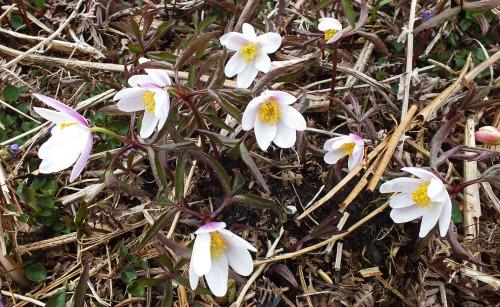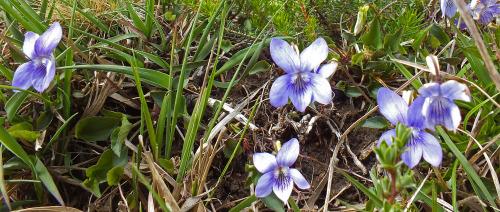
Earlier this month, I went to visit Bunny’s Hill, near Cardinham and Bodmin, with Cornwall Butterfly Conservation (CBC). A beautiful spot in so many ways, our main reason for being there was to see if we could find Pearl-bordered Fritillaries (Boloria euphrosyne).
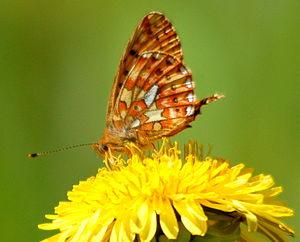
The Pearl-bordered Fritillary (Boloria euphrosyne) (Photo: Wikipedia)
Sadly, we didn’t: the unseasonal cold weather and blustery conditions had presumably delayed the butterflies’ emergence.
It made me think back to 2012 when we made the same trip on the same weekend (and my first ever field trip with my new friends in CBC). Here’s what I wrote in my notebook from that earlier trip:
We were lucky to see a few Pearl-bordered Fritillaries on this, the first warm day of May (and the first warm day since March!). The males fly a little before females and, newly-emerged, they were pristine and beautiful. We found them feeding on nectar from bugle flowers – maybe they like blue, as Common Violet is the only foodplant of their caterpillars. They are also choosy, as Heath Violets won’t do at all..! The silver spots on the underside of their wings were gorgeous: photographs cannot do justice to the iridescence.
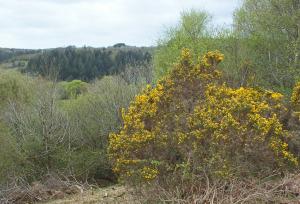
Bunny’s Hill, Cardinham (Photo: Amanda Scott)
I obviously enjoyed the day! I also very much enjoyed Bunny’s Hill this year, even without the butterflies, but it just goes to show what a difference a year can make for wildlife. Natural fluctuations in the weather can obviously affect the timing of emergence and cause short-term population setbacks, and wildlife has survived that for thousands of years. However, these natural variations are increasingly becoming the ‘last straw’ when they overlie habitat loss, pressure from human populations and agricultural intensification (link here to Butterfly Conservation’s recent report on the state of our British butterflies, and here to the equivalent report for moths).
The Pearl-bordered Fritillary is a rare species nationally, and found on only a handful of sites in Cornwall. It is a butterfly traditionally associated with coppiced woodland, of which there is now precious little left, and sites like Bunny’s Hill, with its open bracken-y habitats, perhaps provide an alternative. The good news is that much habitat management work has and continues to be undertaken at Bunny’s Hill by CBC in conjunction with the owners, and this has helped maintain the Pearl-bordered Fritillary population since it was discovered there for the first time by CBC co-founder, Lee Slaughter, on 14th May 1998 – an exciting day he will never forget!
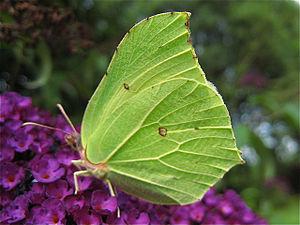
Brimstone butterfly (Gonepteryx rhamni) perfectly matches a leaf when at rest or feeding. The upper surface of the wings is yellow and it is thought that this was the original butter-coloured fly, or butterfly (Photo and caption text: Wikipedia).
Bunny’s Hill is a delightful spot to visit. The Gorse was in full and glorious, coconut-scented bloom, and the views across the landscape were inspiring, even on a windy and chilly day. Looking at my species lists for the two visits, in 2012 and 2013, there is an amazing amount of wildlife to see if you pay attention. Last year, as well as the Pearl-bordered Fritillaries, we also spotted Brimstones, a Green-veined White and a Green Longhorn moth. This year we saw my favorite caterpillar – the Drinker Moth.
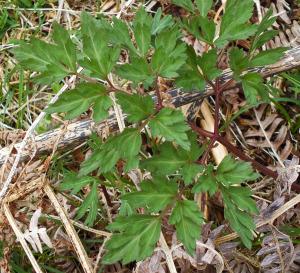
Cornish Bladderseed leaves (Photo: Amanda Scott)
What else can you see? Well, you might find the wonderful Bloody-nosed Beetle, which exudes a foul-tasting red liquid from its mouth when threatened. We found nuts nibbled by Dormice and Wood Mice, and this year we even fleetingly saw a Badger, unusually out in the daytime. Plants include Tormentil, Wood Anemone, Wood Sage, Lousewort and Betony (the last of which, together with the Violets and Bluebells also found there, is an ancient woodland indicator species). We also saw Adder’s-tongue Fern, an indicator of ancient meadow. And, of course, Cornish Bladderseed. This rare umbellifer (a plant of the Carrot family) is only found on a small number of locations in Cornwall and Buckinghamshire, but there is plenty at Bunny’s Hill. It flowers later in the year, in July and August, but its leaves have a delicate beauty underfoot.
Some of Bunny’s Hill is accessible to the public via footpaths. If you would like to visit and experience it for yourself, the grid reference is SX117675: at the fork in the road, turn left, with further parking 50 yards up the track.
